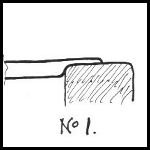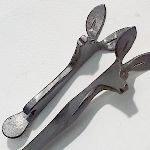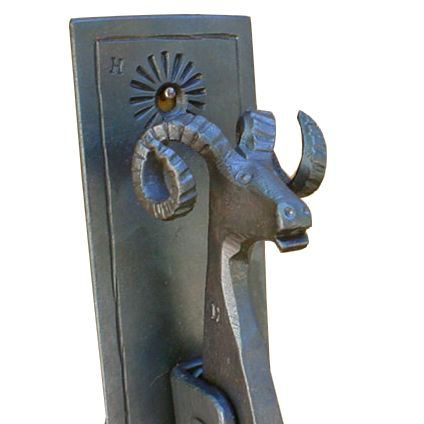| |
 |
 |
 |
 |
JOCK D -
|
 |
Hugh McDonald is best known as the inventer of the McDonald Rolling Mill.
Hugh also forges a wonderful series of animal heads.
His kangaroo heads are shown at the end of our review of his plans for his Rolling Mill.
Last time (November 21, 2001 demo #120) we demonstrated his 2 heat horse head.
Due to the time difference and a slow old computer Hugh has asked me to present his demo.
|
 |
JOCK D -
HUGH McD.
|
 |
"This method of making forged animal heads is fairly quick but needs a high heat and a heavy hammer fo the early stages. My pet 3.75 pound hammer does in eight blows and one heat as my 2.5 pounder does in two heats and twelve or more hits."
|
 |
JOCK D -
HUGH McD.
|
 |
"Later you will need a hot slitting chisel, thin and sharp so you must quench it every few seconds to avoid softening it. (note that the non-tempering steel or high alloy types do not need to be quenched so often - guru). When working on your own a hot cutter with the handle at right angles to the cutting edge makes it easier to see what you are doing. An anvil hold-down is also a must for the lone blacksmith."
|
 |
 |

Figure 1 |
"Use 18" or 20" of 1" x 5/16" flat bar and take a high heat on the end 2".
(Put a blunt point on the end with one tap - added by guru).
|
 |
 |

Figure 2 |
"Put 1" over the the front edge of the anvil (where there is a nice radius) and drive the metal down, keeping the bar upright or it will fold and give a cold shut."
|
 |
 |

Figure 2b |
"Dress the sides as you go."
|
 |
 |

Figure 3 |
"This projection makes the horns (or ears) and should finish 2" long and 1/4" thick and 1/2" wide at the head, tapering to a blunt point."
|
 |
 |

Figure 4 |
"Take a second good heat the the horn projection beyond the main part of the fire to avoid burning it and then put the bar over the far side of the anvil abouf 3/4" holding it at 30 degrees."
|
 |
 |

Figure 5 |
"Drive the metal down so the anvil edge forms the neck and under jaw. Finish the neck not less than 3/8" (or a little thicker than the bar). Soften the shap edges with a few chamfering blows."
|
 |
 |

Figure 6 |
The results should look like this.
|
 |
 |

Figure 7
Click for detail |
Make a convienience bend to get access under the head/jaw.
Also "having someone back up the head with a heavy hammer is a help." Shape the head, lengthing and thickening it. Round as needed.
|
 |
 |

Figure 8 |
"After shaping the head and nose, cut the mouth by heating only the snount and holding it on a sharp cut-off hardie tool and tapping the back of the head. This is much easier than fumbling about trying to get the hot head in the vise and cutting the mouth with a with a chisel. Avoids vise blemishes too."
"Heat the whole head and let it cool slowly to anneal it. DO NOT quench as modern "mild" steel has much "other than iron" and can get quite hard and brittle."
"Punch the nostrils and the eyes cold."
|
 |
JOCK D -
HUGH McD.
|
 |
"If you try to get the these small objects in the vise there will not be enough heat to do much good but plenty to burn flesh. You will also have bashed your fingers, lost your punch in the flurry and got the eys in the wrong place. Cold works fine and is done accurately at your leasure. A big nail set is OK to punch a couple eyse but if you plan any number, make an eye punch from tool steel about 10" long. Paint it yellow as it will invariably creep under other objects and hide when you most need it."
"Now mark the center of the horn (ears) projection with a sharp chisel. Saves grief later."
|
 |
JOCK D -
HUGH McD.
|
 |
"After heating but before seperating the horns I hammer the metal lightly onto a handy piece of scrap with fine threads on it for the horn growth marks. - If you would rather twist the horns they way they don't grow naturaly, fine."
|
 |
 |

Figure 10 |
"Curl the horns hot with round nose pliers and even them up. Wire brush, chop off (the head from the bar) and you are ready for the next."
|
 |
 |

Figure 12 |
"This method is suitable for most animals that need a fair bit of metal for the ears, horns or both."
|
 |
 |

Figure 9 |

Figure 11
Click for detail |

Figure 13
Click for detail |
 |
JOCK D -
HUGH McD.
|
 |
"I use the heads from the 1" x 5/16" in doo knockers but for letter knives and bottle openers I start with 1" x 1/4" bar. Strangely I think the smaller ones are harder to make."
"These sell for about $25 Australian and the door knockers, of which I make four designs, sell for about $70 Aus."
Questions - Comments?
|
 |
sleepingbear
|
 |
Neat animal head, and looks easy enough for even me to do.
|
 |
|
 |
I like it...
|
 |
LEAH
|
 |
Thanks Hugh/Guru, that is a good idea for cutting the mouth. I think and iron bunny would be nice.
|
 |
JIM C.
|
 |
Hugh & Jock: Good demo with clear art work & instructions. Thanks.
|
 |
JERRY
|
 |
great item for shows!! thanky
|
 |
Sleepingbear
|
 |
A Jack Rabbit too
|
 |
Milt
|
 |
Neat heads. If hugh uses 8 hammer hits, how many dozen will one of us beginners need to use?
|
 |
Ntech
|
 |
Great demo. Quick to make. Very well written. Thanks
|
 |
|
JOCK D
|
 |
Milt, Not too many more (hits). As with anything it takes practice. However, Hugh's methods are not hard to learn.
|
 |
JERRY
|
 |
I like the idea of using a threaded piece for the horn marks~learned something new today :)
|
 |
|
 |

Hugh McDonald Ram's Head Door Knocker
|
 |

